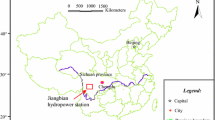Abstract
In order to evaluate the slope stability objectively and prevent geological disasters, the modified efficiency coefficient method was used to evaluate the slope stability. The main factors influencing slope stability were selected as evaluation indicators, including slope angle, slope height, internal friction angle, cohesion, bulk density and pore pressure ratio. The rough set theory was used to simplify the attributes of the slope stability evaluation indicators and determine the weight coefficient of the important indicators extracted. The weight coefficient was applied to the modified efficiency coefficient method to calculate the total efficiency coefficient value of the sample and evaluate the slope stability grade. The comprehensive evaluation model based on rough set and modified efficiency coefficient method is used to predict the stability of a slope project. The results show that the prediction results of this method are consistent with the actual state of the project, and the accuracy of the evaluation using the comprehensive evaluation model is 90.9%, which verifies the validity and reliability of this method. The combination of rough set theory and modified efficiency coefficient method can effectively improve the accuracy of slope stability evaluation and provide a new idea for slope stability evaluation.




Similar content being viewed by others
References
Bordoni M, Bittelli M, Valentino R, Chersich S, Persichillo MG, Meisina C (2018) Soil water content estimated by support vector machine for the assessment of shallow landslides triggering: the role of antecedent meteorological conditions. Environ Model Assess 23(4):333–352
Chen SM, Wu AX, Wang YM (2018) Rock mass quality evaluation based on rough set and modified efficacy coefficient method. J Huazhong Univ Sci Technol (Nat Sci Ed) 46(07):36–41
Contreras LF, Edwin TB (2019) Slope reliability and back analysis of failure with geotechnical parameters estimated using Bayesian inference. J Rock Mech Geotech Eng 11(3):628–643
Fan XM, Qiang X, Gianvito S (2018) Brief communication: Post-seismic landslides, the tough lesson of a catastrophe. Nat Hazards Earth Syst Sci 18(1):397–403
Francioni M, Matteo S, Doug S, Nicola S, Giovanni M, Fernando C (2019) A new fast and low-cost photogrammetry method for the engineering characterization of rock slopes. Remote Sens 11:126711
Gelisli K, Kaya T, Babacan AE (2015) Assessing the factor of safety using an artificial neural network: case studies on landslides in Giresun. Turk Environ Earth Sci 73(12):8639–8646
Li Y, Liu J (2013) Slope instability disaster forecast and its application based on RS-CPM model. J Cent South Univ (Sci Technol) 44(07):2971–2976
Liu DX, Cao P (2015) Preliminary study of modified SMR method based on gray system theory. Rock Soil Mech 36(S1):408–412
Niu JY, Jiang XL, Wang FF (2018) Stability analysis of rock slope with small spacing tunnel under earthquakes and influence of ground motion parameters. Geotech Geol Eng 36(4):2437–2453
Qian ZG, Li AJ, Chen WC, Lyamin AV, Jiang JC (2019) An artificial neural network approach to inhomogeneous soil slope stability predictions based on limit analysis methods. Soils Found 59(2):556–569
Qie ZH, Wu XM, Lian JJ, Wang FZ (2006) Stability evaluation of rock slope basing on rough set. In: 2006 International conference on machine learning and cybernetics. New York, pp 2310
Sun SQ, Li SC, Li LP, Shi SS, Wang J, Hu J, Hu C (2019) Slope stability analysis and protection measures in bridge and tunnel engineering: a practical case study from Southwestern China. Bull Eng Geol Environ 78(5):3305–3321
Wang YC, Sun HY, Shang YC (2010) Application of efficacy coefficient method to instability risk early-warning of tunnel surrounding rock. Rock Mech Eng 29(S2):3679–3684
Xu J, Zhang Q, Wu JM (2010) Application of efficacy coefficient method to determination of rock preferred structrual plane. Geotech Eng 29(S2):3679–3684
Yang CZ, Tao XM, He GX (2009) The application of gray theory in slope analysis. Aussino Acad Publ House, Marrickville, pp 549–552
Zhang J, He P, Xiao J, Xu F (2018) Risk assessment model of expansive soil slope stability based on Fuzzy-AHP method and its engineering application. Geomat Nat Hazards Risk 9(1):389–402
Zhou Z, Cui X Y, Niu Y L (2011) Reseach of security risk identification based on rough set theory for Highway Subgrade stability in the slope of reservoir. In: International conference on management science and engineering 18th annual conference proceedings, New York, pp 1144.
Zhao ZF, Xu WY (2007) Comprehensive assessment of slope safety and stability based on catastrophe theory. Rock Mech Eng 26(S1):2707–2712
Acknowledgments
This research was supported by the National Key Research and Development Program of China (No. 2018YFC0808402).
Author information
Authors and Affiliations
Corresponding author
Additional information
Publisher's Note
Springer Nature remains neutral with regard to jurisdictional claims in published maps and institutional affiliations.
Rights and permissions
About this article
Cite this article
Qiao, C., Li, Ch. & Xiao, Yg. Application of Rough Set Method Based on Modified Efficiency Coefficient in Slope Stability Analysis. Geotech Geol Eng 38, 5603–5612 (2020). https://doi.org/10.1007/s10706-020-01516-x
Received:
Accepted:
Published:
Issue Date:
DOI: https://doi.org/10.1007/s10706-020-01516-x




